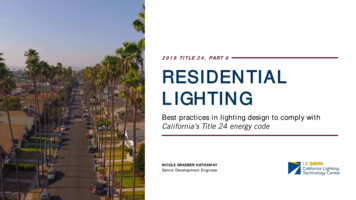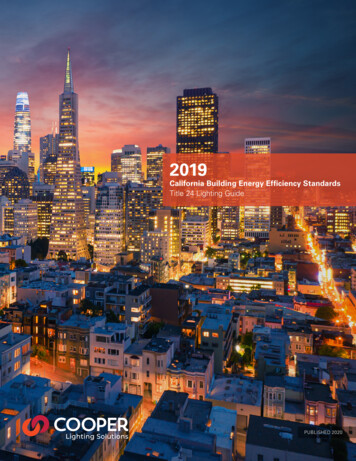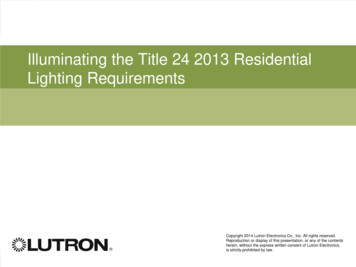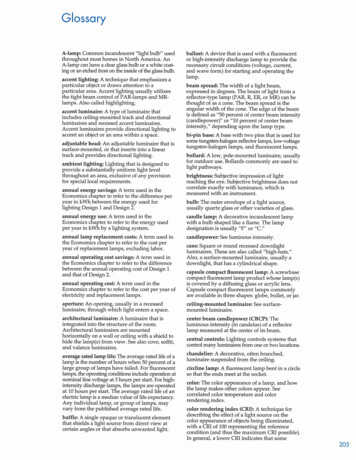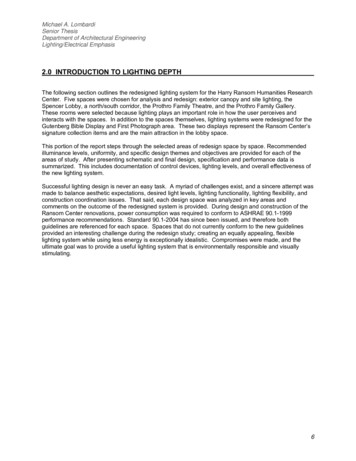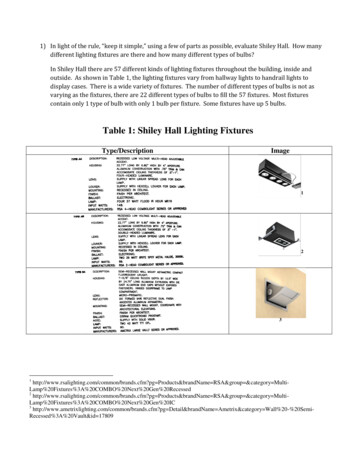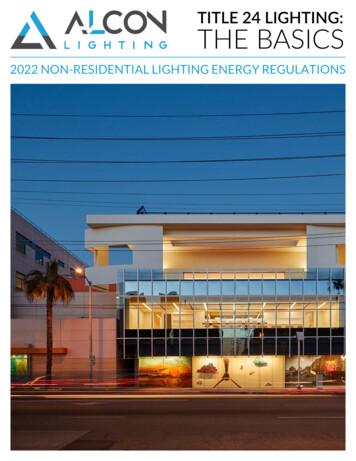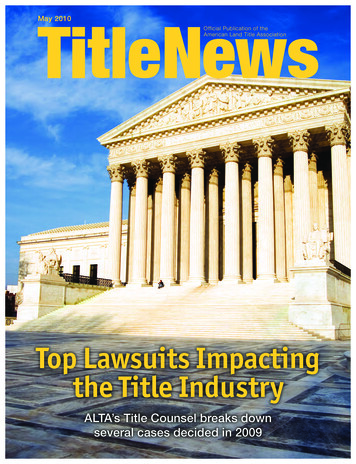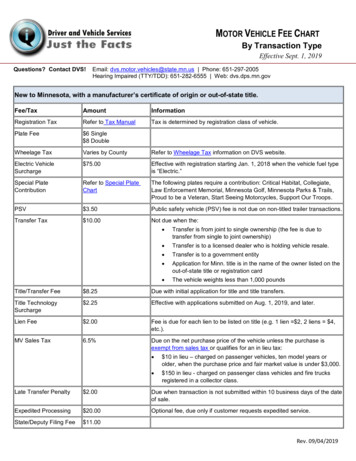
Transcription
Changes to Title 24 LightingRequirementsCalifornia's new building energy efficient standards took effectJuly 2014. The goal is to make nonresidential buildings 30%more energy efficient than the previous 2008 standards.The next 16 slides give an overview of the importantrequirements and major updates to the lighting codeBill Blackley LCDirector Product Marketing
Changes to Title 24 LightingRequirements New requirements for lighting controls initiates one ofthe biggest changes to Title 24 standards. The new standard also includes stricter requirementsfor testing and certification of controls commissioning. All lighting control systems with two or morecomponents in non-residential spaces must meet therequirements of 2013 Title 24 standards section 110.9. Stand-alone and luminaire integrated lighting controlssuch as occupancy/vacancy sensor and photocontrolsmust now comply with Title 20 regulations.
Changes to Title 24 LightingRequirementsNon Residential Indoor Lighting Requirements All interior luminaires in non-residential buildings musthave manual on/off controls. Each area must be independently controlled. Dimmer switches must allow manual on/offfunctionality with some exceptions such as publicrestrooms with two or more stalls, which do not need apublicly available switch.
Changes to Title 24 LightingRequirementsMulti-Level Lighting ControlsIn areas larger than 100ft² installed luminaires must: Incorporate multi-level lighting controls or continuous dimmingdepending on the lamp type. Meet uniformity levels as per Table 130.1AHave at least one of the following types of controls for each luminaire Manual continuous dimming and on/off control (Section 130.1(a)) Lumen maintenance (Section 100.1) Tuning (Section 100.1) Automatic daylighting controls (Section 130.1(d)) Demand response controls (Section 130.1(e))Note:Classroom lighting is one of the rare exceptions to multi-level requirements. If they have a connected generallighting load 0.7W/ft² they must have at least one control step between 30% and 70% of full rated power.
Changes to Title 24 LightingRequirementsAutomatic Daylighting Controls In section 140.3(c) of the 2008 code only 50% of the floor area inbuildings over 8,000 ft² was required to be in daylighting zones.Section 130.1(d) of the 2013 code requires that floor plans have75% of their total area in daylighting zones in building greaterthan 5000 ft². In daylighting zones controls requirements have become moreexacting. In the 2008 code only sky-lit spaces 2,500 ft² and sidelit spaces 250 ft² had to have daylighting controls. Section130.1(d) requires multi-level automatic daylighting controls in allSky-lit or Side-lit zones where the installed general lighting poweris 120W
Changes to Title 24 LightingRequirementsOccupancy Lighting ControlsSection 119 requires occupancy sensing lighting controlsin the following areas: Offices 250 ft² Conference rooms of any size Multipurpose rooms 1000 ft² Classrooms of any size Secondary spaces Indoor parking areasNote:Indoor parking areas including parking garages and secondary spaces are new additions to the code
Changes to Title 24 LightingRequirementsSecondary SpacesThe 2013 code demands that occupancy sensing controls mustautomatically reduce lighting power by 50% in these secondaryspaces when unoccupied: Corridors and Stairwells Warehouse aisles and open areas Library book shelve aisles 10ft in length accessible from oneend or 20ft in length accessible from both ends
Changes to Title 24 LightingRequirementsSecurity and Egress Lighting Maximum security egress lighting allowance of 0.2W/ft²when building is occupied. General and egress lighting must be shut off duringunoccupied times.Exception: Offices are allowed up to 0.05W/ft² for lighting duringunoccupied periods only along emergency egress areasdesignated on the building plans
Changes to Title 24 LightingRequirementsTable 130.1-ALuminaire TypeMinimum required control steps (% offull rated powerUniform level of Illuminance shall beachieved by:LED luminaires and LED source systemsContinuous dimming 10 – 100%Pin based CFL 20WContinuous dimming 10 – 100%Linear fluorescent 13WHID 20WInduction 25WOther Light SourcesMinimum one step in each range20-40%50-70%80-85%100% Stepped dimming Continuous dimming Switching alternative lamps in eachluminaire having a minimum of 4 lampsper luminaireMinimum one step between 50-70% Stepped dimming Continuous dimming Switching alternative lamps in eachluminaire having a minimum of 2 lampsper luminaire
Changes to Title 24 LightingRequirementsDemand Response ControlsThe 2013 code requires that all non-residential buildings 10,000 ft² be capable of automatically responding to a DRsignal so that: Total energy use for lighting can automatically drop to alevel at least 15% below the buildings maximum totallighting power. Lighting is reduced in a manner consistent withrequirements of uniformity levels as per Table 130.1-ANote:Non habitable spaces must not be used to comply with this requirement, spaces with a lighting power density 0.5W/ft² are not counted toward the buildings total lighting power. Designers remain responsible for specifyingautomated controls that are compatible with the local utilities DR protocol
Changes to Title 24 LightingRequirementsParking Garages & AreasIn Title 24 parking garages are classified as indoor spaces and mustcomply with Section 130.1(c)7B. Top level roof areas are theexception, these must comply with Section 130.2. The followingregulations are new for parking garages. In parking garages, indoor parking areas, loading and unloading areas, generallighting must be controlled by occupancy sensing controls having at least one controlstep between 20% & 50% of design lighting power.In a parking garage area with a combined total of 36 ft² or more glazing or openings,luminaires providing general lighting, combined in primary and secondary daylit sidelit zones must be controlled independently with automatic photocontrols.Automatic daylighting controls must be multi-level continuous dimming or on/off.When primary side-lit zones receive sufficient daylight to reach Illuminance levelsabove 150% of that provided by electric lighting when no daylight is available, controlsmust reduce lighting power to zero
Changes to Title 24 LightingRequirementsOutdoor Lighting Requirements Outdoor lighting must be circuited and independentlycontrolled from other electric loads. All outdoor luminaires with lamps 150W must complywith the IES BUG system for assessing and limiting uplightand GLARE. No backlight requirements in this iteration of the code
Changes to Title 24 LightingRequirementsAutomatic daylighting controlsTitle 24 2008 required photocontrol devices for all outdoorlighting. In addition to photocontrols the 2013 standardsrequire automatic scheduling controls. Astronomical timeclocks that automatically turn lights off during the day areallowed as and alternative to photocontrols. Section 130.2(c)addresses these requirements
Changes to Title 24 LightingRequirementsLuminaires mounted 24ft above the groundIn addition to photocontrols and automatic scheduling Section 130.2(c) also requiresoccupancy sensing for certain outdoor lighting applications. No more than 1,500W oflighting power may be controlled together for outdoor lighting of this type. Automaticlighting controls for these luminaires must: Utilize motion sensors or another automatic lighting control system, in addition tophotocontrols and automatic scheduling controls for astronomical clocks. Be capable of automatically reducing the lighting power of each luminaire by at least 40%but not more than 80% or provide continuous dimming through a range that includes 4080% during vacant periods. Switch on automatically when the area becomes occupied.ExceptionsThese types of lighting constitute exceptions to the above requirements Pole mounted luminaires with a maximum rated wattage of 75W Non pole mounted luminaires with a maximum rated wattage of 30W Linear lighting with a maximum wattage of 4W per linear foot of luminaire Outdoor sales, frontage, lots and canopies
Changes to Title 24 LightingRequirementsOutdoor Sales LightingThe 2013 code adds Occupancy sensing controls to therequirements for outdoor sales lighting for frontage areas,lots and canopies. Lighting controls in these areas mustmeet the requirements that apply to all outdoor lighting andthey must automatically: Reduce lighting power by at least 40% but not more than80% during vacant periods Switch to the higher lighting level when the spacebecomes occupied.
Changes to Title 24 LightingRequirementsBuilding facades ornamental hardscape and outdoor dining areasLike outdoor sales areas these areas must have lightingcontrols that reduce energy use during unoccupied periodsand automatically increase light levels when the spacebecomes occupied. One or both of the following controlsstrategies are allowed:Motion sensors capable of automatically reducing lightingpower by at least 40% but not more than 80% during vacantperiodsA centralized time based zone lighting control capable odautomatically reducing lighting power by at least 50%Note:Wall packs identified by the IES handbook as outdoor wall mounted luminaires having bilaterally symmetricdistribution must comply with the acceptable requirements in Section 130.2(c)3 where the bottom of the luminaireis mounted 24ft above the ground.
Changes to Title 24 LightingRequirementsCommissioning & Acceptance Testing RequirementsTitle 24 now requires that a commissioning report be completedand provided to each building owner. This includes reports on allfunctional performance tests completed as part of the acceptancetest process.Projects issued a building permit must undergo acceptance testingfor: Automatic daylighting controls Automatic time switch controls Occupancy sensors Outdoor lighting shut off controls Outdoor motion sensors Demand response (DR) controlsNote:Testing of DR controls is a new requirement under Title 24 2013. Building commissioning requirements are addressed in Section 120.8Lighting controls acceptance test technicians must be certified through an approved training program such as the California AdvancedLighting Controls Training Program (CALCTP) and registered with the State of California. Technician employers must also be certified.Technician training and certification requirements are addressed in Section 13.11 (page 1049) of the non-residential compliance manual.
the biggest changes to Title 24 standards. The new standard also includes stricter requirements for testing and certification of controls commissioning. All lighting control systems with two or more components in non-residential spaces must meet the requirements o
